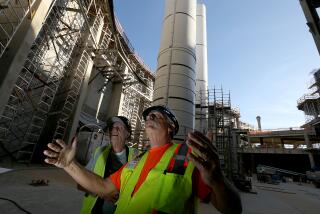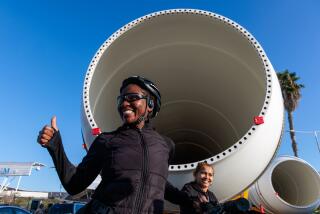3rd-Graders Get Close-Up Look at Apollo 11 Engines
- Share via
Eight-year-old Rogelio Banales was clearly awe-struck by the massive engine in front of him, the J-2 that helped send the Apollo 11 crew to the moon 30 years ago.
Next to it was the F-1, the most powerful engine ever built. It provided the spacecraft with 7.6 million pounds of first-stage thrust.
“Wow! That is very cool!” Rogelio said. “I know I’ll see another one again, because I’m going to be an astronaut.”
Rogelio, a third-grader at Sylvan Park Elementary School in Van Nuys, felt lucky to be one of only three kids to see the historic engines at a private lunchtime exhibit Tuesday at Rocketdyne Propulsion and Power.
In 1969, Rocketdyne supplied the Apollo/Saturn V with 30 engines built at the Canoga Park plant. The rocket made history, carrying the Apollo 11 crew to the moon and safely back to Earth.
On Tuesday, Rocketdyne commemorated the mission by displaying several of those engines in the parking lot.
The event was for employees only, but Rogelio’s teacher, Jan Hingert, had taken a class at Rocketdyne a few weeks ago and asked that she be allowed to bring along three of her students interested in rockets.
“It really is fabulous for the kids to actually see this in person,” Hingert said. “It’s very special for them.”
On hand were engineers who helped build the F-1 and J-2. And there were lots of Moon Pies, chocolate-covered marshmallow sandwiches.
Engineer Ronald Urquidi, who worked on both engines, said the technology was ahead of its time.
“They are very intricate,” he said. “The J-2, for instance, runs on liquid hydrogen and oxygen. It took close to 10 years to make.”
Rogelio and his two classmates listened closely, eyes wide open and Moon Pies in hand.
More to Read
Sign up for Essential California
The most important California stories and recommendations in your inbox every morning.
You may occasionally receive promotional content from the Los Angeles Times.













